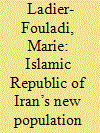|
|
|
Sort Order |
|
|
|
Items / Page
|
|
|
|
|
|
|
| Srl | Item |
| 1 |
ID:
191082


|
|
|
|
|
| Summary/Abstract |
This article explores how the deportation of the Dargin people in the Caucasus affects intergenerational fertility rates and assesses the results of the experiment. The authors paid attention to two Dargin settlements located in the foothills and Mid-Mountains areas of Dagestan, the first of which was subject to forced replacement, but the other was left intact. Inhabitants of both settlements have close kinship ties and are tied by commodity trade as well. The authors obtained data through municipal registers and an additional survey conducted in the studied localities. We used event history analysis as the main methodology. The main findings cover the following: the foothill settlers managed to keep the social norms along with handicrafts that existed before deportation which brought about the intergenerational continuity in procreative behaviour and higher childbirth rates in the foothill settlement that have persisted for a long time.
|
|
|
|
|
|
|
|
|
|
|
|
|
|
|
|
| 2 |
ID:
159031


|
|
|
|
|
| Summary/Abstract |
Using micro-data from the Taiwan Population and Housing Census, this study estimates the causal effect of fertility on the labor supply of married women. To address the endogeneity of fertility, we exploit exogenous variations in the number of children caused by twin births, which can be considered a natural experiment. The instrumental variable estimates indicate that an additional child reduces female employment by 10.5 percentage points for those who have at least one delivery, and the effects gradually decline for females who have two or more deliveries, with the effects vanishing when females have three or more deliveries. Also, the effect of fertility varies substantially with the time elapsed since the last childbirth, which has a consequence for differences in estimates across different samples in the literature.
|
|
|
|
|
|
|
|
|
|
|
|
|
|
|
|
| 3 |
ID:
177693


|
|
|
|
|
| Summary/Abstract |
This study aims to document the age structure and mortality by age in the Ottoman city of Bursa that served as a politically and commercially significant urban center over centuries. It uses a set of hitherto unexamined Ottoman population registers kept in 1839 and updated until 1842 that provide detailed self-reported data on all male inhabitants regardless of age, including deaths, births, and migration. The study tests the quality of age and mortality data in conjunction with the Coale and Demeny regional model life tables and compares the results to historical demographic studies conducted for European regions. The results point to a demographic structure marked by high birth and death rates and prove promising for extending back the study of Ottoman demographic transition and establishing historical comparison points with the global experience.
|
|
|
|
|
|
|
|
|
|
|
|
|
|
|
|
| 4 |
ID:
121196


|
|
|
|
|
| Publication |
2013.
|
| Summary/Abstract |
We explore the effect of female autonomy on individual fertility in Nepal. We find that families where wives have high level of autonomy have fewer children than other families. Using gender of the first child as a natural experiment, we also find that son preferences are present in Nepal. Moreover, the results indicate that women have more influence when the first born is a boy, compared to when the first child is a girl. We discuss policy implications with respect to the problem of excess children due to son preference.
|
|
|
|
|
|
|
|
|
|
|
|
|
|
|
|
| 5 |
ID:
193002


|
|
|
|
|
| Summary/Abstract |
This study examines how individuals' fertility outcomes were affected by the labor market conditions they experienced at graduation. Using data from the Chinese General Social Survey, it finds that poor labor market conditions at graduation delayed individuals' entry into parenthood. Higher unemployment rates at graduation reduced the probability of having at least one child in the survey year for both men and women. The negative fertility effects generally followed a U-shape, reached the maximum around average childbearing ages, and faded out within 15 years after graduation. Low-skilled workers mainly contribute to the negative fertility effects observed in the whole sample. Employment and marital outcomes are also analyzed as potential mechanisms. Estimation results indicate that individuals who experienced poor labor market conditions at graduation delayed marriage and the birth of the first child due to a lower probability of being employed, reduced working hours, and adverse income shocks. The negative long-term fertility effects should be brought to policymakers' attention, especially when China's low fertility issue worsens. Policymakers are expected to create more favorable employment conditions for labor market entrants to encourage fertility and expand the future working-age population.
|
|
|
|
|
|
|
|
|
|
|
|
|
|
|
|
| 6 |
ID:
180029


|
|
|
|
|
| Summary/Abstract |
After dropping rapidly and steadily over two decades, fertility in Iran stabilized between 2001 and 2011 at around 1.9 to 2 children per woman, before starting to rise slightly between 2012 and 2016, then falling fairly quickly. This coincided with the implementation of the Islamic Republic’s new population policy, with its aggressive and coercive measures, one of whose goals was to reverse the downwards trend in fertility. Given changes in proximate and remote determinants of fertility in Iran, and the decline in fertility since 2016, it is assumed that this new population policy triggered a reduction in intervals between births between 2012 and 2015, leading to a slight rise in the fertility of already married couples. The other latent objective of the Islamic Republic’s new population policy is to drive Iran’s population up to 150 million inhabitants in the near future. This is utopian given Iran’s demographic dynamics, but it conceals the political and ideological goal of asserting Iran’s demographic and geopolitical significance within the region, by drawing on a novel immigration policy to make up for its low fertility.
|
|
|
|
|
|
|
|
|
|
|
|
|
|
|
|
| 7 |
ID:
191148


|
|
|
|
|
| Summary/Abstract |
We build a simple overlapping generation model to investigate the effect of life expectancy on the real exchange rate where fertility is chosen endogenously. The model reveals that, although the overall effect of life expectancy on the real exchange rate is not certain, longer life expectancy tends to cause the real exchange rate to depreciate by reducing fertility. Fertility thus serves as a mediator in the effect of life expectancy on the real exchange rate. Evidence from 148 economies (1980–2018) shows a statistically significant and robust negative relationship between life expectancy and the real exchange rate. It is estimated that a 1 year increase in life expectancy is associated with a 1.5 percent depreciation in the real exchange rate. The evidence also confirms the mediated effect of fertility. The mediated effect that fertility exerts accounts for 30 percent to 50 percent of the total effect, depending on the real exchange rate index used.
|
|
|
|
|
|
|
|
|
|
|
|
|
|
|
|
| 8 |
ID:
187869


|
|
|
|
|
| Summary/Abstract |
This study investigates how traditional patrilineal family institution influences women's income through fertility behavior by offering evidence from family lineage (zongzu) in China. We hypothesize that family with strong lineage—proxied by owning genealogy—has a negative effect on women's income through the son-targeting fertility behavior. Using a difference-in-differences strategy, this study confirms the hypothesis. Relative to the women whose first child is a son, the women marring into families owning genealogy indeed have more children and lower income, if their first child is a daughter. In contrast, such finding does not hold for the male sample. Preliminary evidence suggests that shorter work time can explain the findings.
|
|
|
|
|
|
|
|
|
|
|
|
|
|
|
|
| 9 |
ID:
160819


|
|
|
|
|
| Summary/Abstract |
Fertility is one of the elements in population dynamics that makes a significant contribution towards changing population size and structure over time. In Ethiopia, for the last 10 years the total fertility rate (TFR) has declined slightly from 5.5 to 4.8 children in 2011. But, the TFR in urban areas has increased from 2.4 to 2.6 per 1000 live births. The Bongaarts model was applied to estimate the indices of the four main proximate determinants of fertility. Bongaarts defines the TFR of a population as a function of the total fecundity rate (TF), index of marriage (Cm), index of contraception (Cc), index of postpartum infecundability (Ci), and index of abortion (Ca); this can be written as TFR = Cm × Cc × Ci × Ca × TF. In 2005, the index of married women in urban areas was lower than rural, but it was unfortunately the same in urban and rural areas in 2011. For the last decade, the index of postpartum infecundability had a great fertility reduction effect compared with the contraception index and marriage index in rural Ethiopia. The lower the four indices of proximate determinants, the more fertility will be reduced. As such, the Ethiopian government, international non-governmental organizations and policy-makers must pay attention to increase the prevalence of contraceptive use and educate society to fight against child marriage. Permanent contraceptive use, such as female sterilization, should be promoted; moreover, legal organizations and the community must work together to raise the legal age of marriage to 18 years.
|
|
|
|
|
|
|
|
|
|
|
|
|
|
|
|
| 10 |
ID:
092243


|
|
|
|
|
| Publication |
2009.
|
| Summary/Abstract |
This article examines the Japanese literature on the current phenomenon of low fertility in Japan, which persists despite the understanding shared by most Japanese that children are valued. By reviewing existing research on low fertility in Japan, the article examines the emergence of low fertility and introduces a new perspective that links the phenomenon to the larger context of social change in Japan. Analysis of the literature reveals that low fertility is paradoxically accompanied by a persistent or enduring desire to have children, as stated by a majority of interviewees. This paradox between desire and behaviour signifies social change that demonstrates both discontinuity and continuity of marriage- and family-related practices and processes in Japanese society.
|
|
|
|
|
|
|
|
|
|
|
|
|
|
|
|
| 11 |
ID:
176477


|
|
|
|
|
| Summary/Abstract |
The lives of Southeast Asian caregivers in Taiwan are regulated by a number of laws and policy measures that preclude them from naturalisation, deprive them of a family life, restrict their residency, mobility and employment, and, in the past, have suspended their fertility. They are thus excluded from Taiwanese society and alienated as temporary, supplementary and disposable outsiders in line with broad public opinion. ‘Bringing the state back in’ to its analysis, this article argues that this legislation is not only market‐driven but socio‐politically expedient in that it sanctions the continued employment of foreign caregivers as productive workers rather than as fertile women, while simultaneously casting them as the undesirable other. Taiwan thus becomes a ‘migration state’ with an open economy but a closed national community. Drawing on key government sources as well as longitudinal social surveys, the article demonstrates how this state‐anchored expediency enjoys consistent public endorsement. In focusing on how and why Southeast Asian caregivers' fertility was suspended, it introduces a much‐needed gender perspective to our understanding of how migrant women become ‘disenfranchised class’ in the hostile guest worker system.
|
|
|
|
|
|
|
|
|
|
|
|
|
|
|
|
| 12 |
ID:
174888


|
|
|
|
|
| Summary/Abstract |
This article aims to examine the relationship between women’s household bargaining power and their adoption of modern contraception in post-Soviet Tajikistan using the 2012 Demographic and Health Survey. The study uses direct measures of bargaining weights: a woman’s ability to make decisions about her own health care; visits to her family or relatives; and contraceptive use. An additional measure defining a woman’s financial capability to receive medical treatment for herself is added in the analysis to understand its correlation to women’s contraceptive-use behaviour. The probability of using contraception is 187 percentage points higher for a woman who has both control over her own health care and financial means to get medical help than a woman who does not have these choices. Having a say in the decision to control births increases the probability of using contraception by 98 percentage points. Our findings reveal that certain aspects of a woman’s household decision-making and financial freedom are relevant to explain her contraceptive-use behaviour.
|
|
|
|
|
|
|
|
|
|
|
|
|
|
|
|
|
|
|
|
|